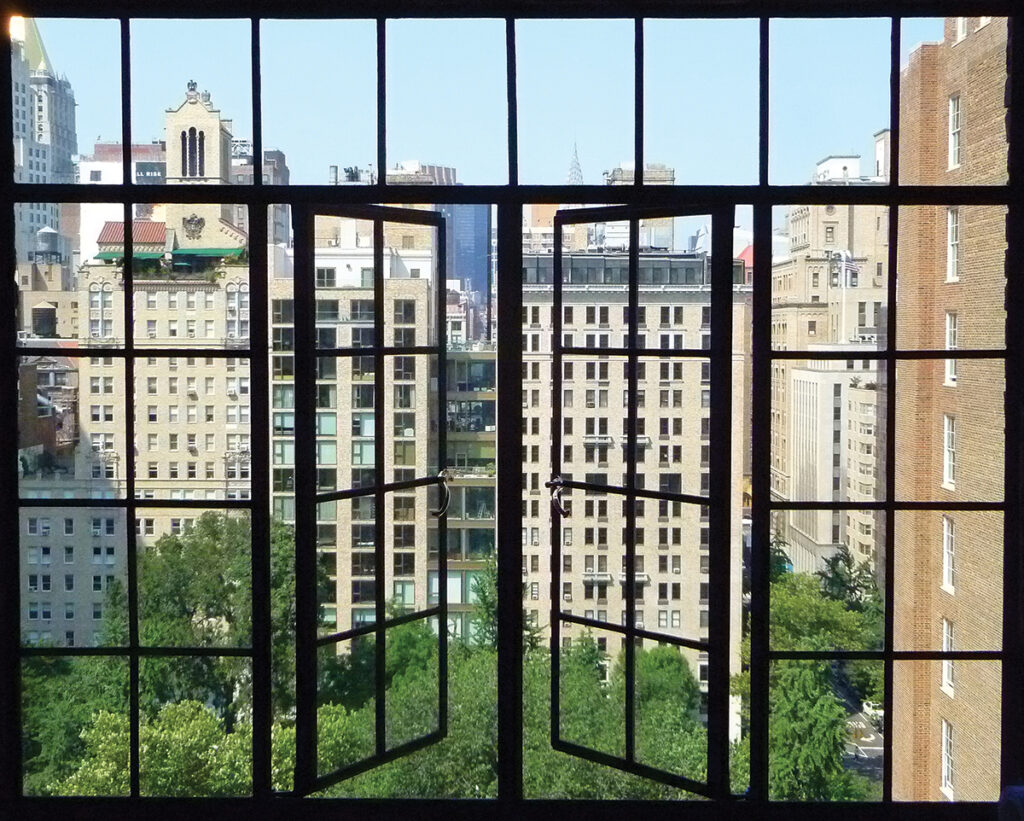
Dating from the Middle Ages, casements are the earliest type of movable windows. More recently, they appear in revivals of English and European styles including Gothic, Norman, chalet, Tudor, and Elizabethan. They also show up in Prairie houses, Arts & Crafts bungalows, and modern 20th-century homes.
Although most common in American homes built between the two World Wars, steel windows have a much longer history. Casement windows were produced as early as 1818 in England, where the still-active company Hope’s was born. Usually made of virgin steel, frames of vintage windows are typically harder and have greater tensile strength than modern windows made with recycled steel. A short list of past manufacturers includes Hope’s, Crittall, Detroit Steel, Fenestra, Lupton, Thorn, and Trusscon. Vintage catalogs for several of these makers can be found online at archive.org.
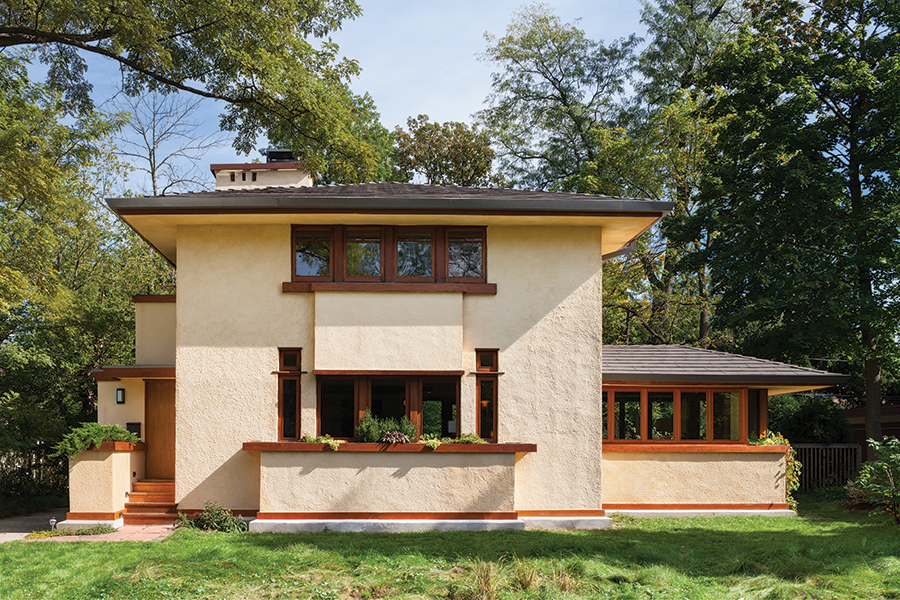
While the image of flinging windows open wide is blissfully romantic and picturesque, several downsides come with windows that break the plane of the house, starting with the incursion of mosquitoes, gnats, and flies and culminating with rain (even snow!) that blows inside. A casement window can be damaged by the force of water or wind warping or knocking it out of alignment. Once a casement is warped even slightly, it may not close securely, leaving the house vulnerable to leaks and drafts. Whether the frame is wood or metal, these historic windows are usually single-glazed, introducing cold through convection. No wonder many have been replaced with insulated swing-up, swing-out, or fixed windows.
Still, anyone fortunate enough to have original casements on their Twenties lake camp, Tudor house, or Art Deco apartment should treasure these rare survivors. Often an essential part of the design, original casements can last practically forever with care and reconditioning.
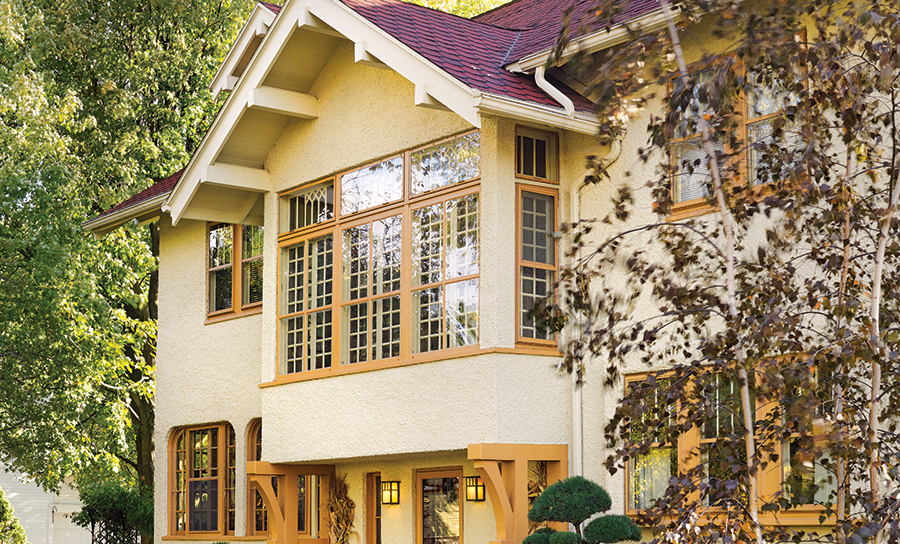
Photo: Gridley + GTgraves
Wood casements appear in all sorts of houses built before 1945; they could be ordered from builders’ catalogs in dozens of configurations. Simple and sturdily constructed, they usually feature concealed, mortised butt hinges and simple “cupboard turn” catches. From a DIY standpoint, working on a wood casement window isn’t much different from working on a glazed cabinet door of the same era; however, getting a tight fit in the window frame is essential to prevent air infiltration. In contrast, steel casement windows were made by multiple manufacturers, all of whom offered their own proprietary designs with unique hinging systems, sash bolts, and hardware.
Wood Casement Repairs
Wood casements are much easier to repair than metal, especially if the wood is still sound. Typical problems include windows painted shut with multiple coats of paint, damage from weather exposure and rot, and missing operating hardware.
Freeing Casement Windows from Storm Sashes
If your casements are covered by exterior acrylic “storm sashes,” as mine were, get rid of those. Although makeshift storms keep drafts out, they noticeably block light and tend to scuff and yellow, further reducing visibility. One easy solution is to replace them with acrylic or glass interior storms, which can be removed and exchanged for screens in warm weather .
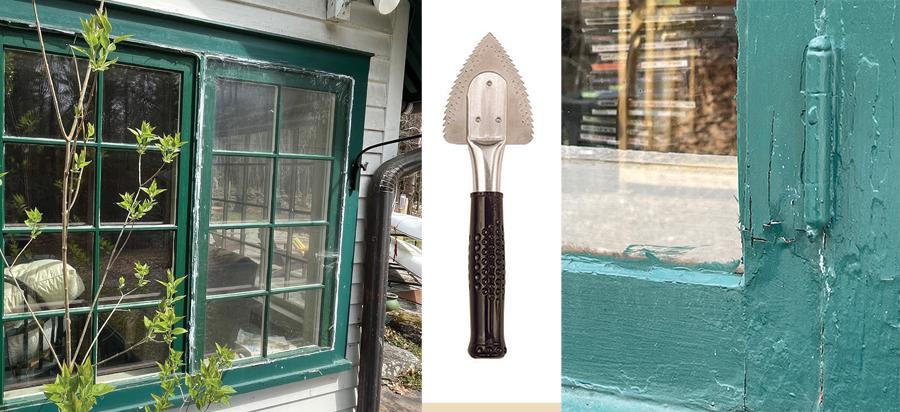
Freeing Painted-Shut Wood Casement Windows
Using a serrated Window Zipper tool, work the tool between sash edges to crack the paint seal. Then gently tap on solid wood at the corners of the window sash, from the inside, with a rubber mallet, until the casement starts to move. (It’s helpful to have someone on the outside to help push and pull.) Once the window is free, swing it open and shut a few times. You may have to loosen or tighten the hinges to get the windows in proper operating order.
Repairs for Wood Casement Windows
Windows that have been painted shut and subjected to strong sunlight will have blistered paint; the wood underneath may be dried out and damaged. Glazing putty is likely to have dried and failed as well. Wood repairs are similar to those for double-hung sash windows, but casements call for some special treatment. First, remove as much of the blistered, chipping paint as possible. Assume lead paint is present and wear protective eyewear and an N-95 or cartridge respirator mask. After scraping, make any necessary patches and repairs to the wood. Epoxies specially formulated for wood, such as WoodEpox and LiquidWood, work wonders on punky or rotted wood. Remove old glazing putty and reglaze with new putty. If the wood in the casements is especially dry, treat it to a blend of boiled linseed oil and turpentine at a 1 to 1 ratio. Prime everything with an alkyd or linseed-oil primer and top with two coats of alkyd or linseed-oil paint.
Hardware
If hinges or other operable hardware are so covered with paint they won’t budge, remove caked-on material, by scraping or stripping or both. You may need to remove the hardware or even the entire window. One idea: Put the hardware in an old slow-cooker that’s no longer used for food, cover with water, and let “cook” on the lowest setting overnight.
If essential hardware is missing—the casement stays (sash operators) are usually the first to go—look for replacements at salvage dealers, or order new ones from a restoration hardware source. Placement is key for a sash operator; the operator should be positioned on the sill so that there is at least a 90-degree swing when the window is open. Ideally, the operator shouldn’t project beyond the window frame when the window is partially open (even though some historical sash operators are designed exactly that way!), or it will be impossible to fit a screen.
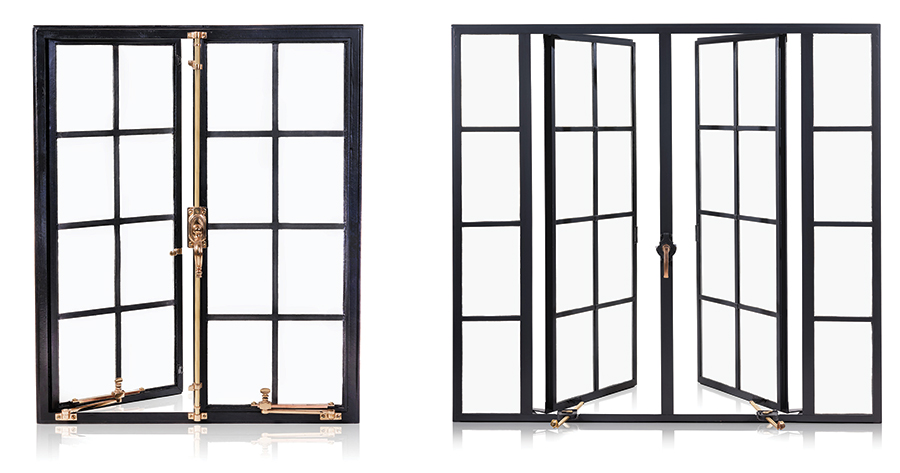
RIGHT: A large opening is fitted with a double casement window and fixed sidelights. Note how the casement operators slide through mounts on the edge of the sash. Photo: Todd Seekircher/Seekircher Steel Window
Steel Casement Repairs
Steel windows were built to last. While most steel casements in American homes and apartments date to the 1920s and ’30s, solid, hot-rolled steel windows have been made for more than 200 years. (Some were even double glazed and came with insect screens!) A full retrofit generally requires calling in a pro, but a homeowner can take several repair steps.
Hinges sticky or frozen shut?
Start by removing built-up paint on the movable parts of hardware, and wherever the sash is meant to lap against or over the frame. Wire-brushing, maybe along with a chemical paint stripper formulated for metal, may help. (Take care not to disturb any mortar, especially if the window sashes are embedded in it.) A few drops of penetrating oil may loosen frozen or rusted parts. Sliding bolts can be refreshed with a drop or two of 3-in-1 oil.
Alignment Adjustments
A steel window should meet its frame on four edges at the same time. Try small adjustments to stretch the metal back into position, using a thin metal shim. “You can use a dime, a quarter, a washer—it all depends on how big the gap is and how much adjustment it needs,” says Todd Seekircher of Seekircher Steel Window. Call in a professional if windows are seriously out of alignment, have cracked glass, or other damage. Same for frames with eroded or rusted-through sections.
Hardware
If the finish on highly decorative sash locks is pitted or discolored, a metal restoration service can replate. If operable hardware is missing or damaged beyond repair, in most cases you’ll need to find salvaged replacements. It’s important to know what brand and model you have, as even slight variations mean the salvaged part won’t fit properly.
Reglazing and Painting Steel Casement Windows
Clean out old putty, saving the glazing springs that hold the pane in place. (Swisco and others make replacements.) If you remove the glass, wire-brush the opening and paint with a metal primer. Lay a bead of linseed oil-based putty in the channel before resetting. Use the metal clips to hold glass in place, then apply the putty, cutting it back at an angle.
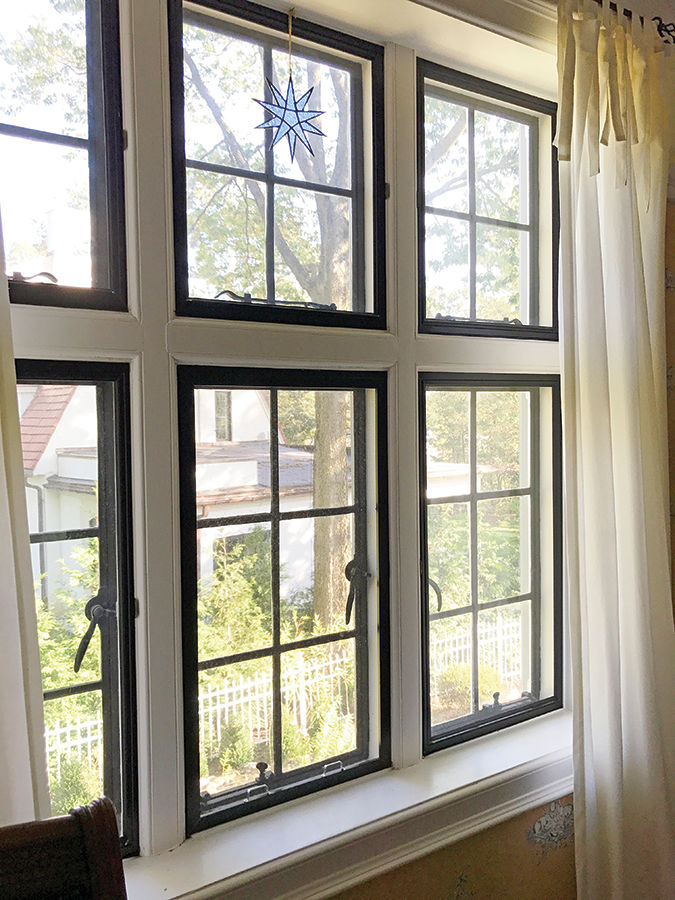
Kits For Casements
Love the idea of operable windows in summer, but worried about winter drafts and heat loss? Outfitting your casements with interior inserts of acrylic or glass can reduce energy costs up to 20 percent. What’s more, inserts easily pop into place and may be swapped out for flexible screens (like those from FlexScreen) during warm weather. At least one company, Allied Windows, offers inserts for both outswing and inswing casements; the exterior ones—best for fixed casements—are designed and painted to match the historic window profile. Inswing models may be ordered with an interchangeable screen insert.
As different companies offer different systems and different glazing options, look at products from more than one company. For example, Indow offers at least three types of acrylic inserts, including the standard, a twice-as-thick acoustic, and a UV-blocking museum grade. Glass lasts longer and maintains clarity better than acrylic, but it is far heavier, so large inserts may be difficult to maneuver. You’ll need a place to store window inserts and screens as the seasons change.
Closing For the Season
Wood casement windows that have been open all summer may swell, making it hard to close them fully. (The open side may be misaligned—say, dropping down and too wide at the top while the bottom appears to have a gap.) If that’s the case, try loosening the screws on the interior hinge plates. This will permit play in the window.
With a helper, lift and push up or down on the window as needed until the open edge of the window more-or-less lines up with the casement.
Tap along the stile with a soft rubber mallet. If one area overhangs the casement, keep lifting and shifting the window until you can see the beginnings of a gap. Then tap firmly up and down the stile. You may also need to tap the window along the rail at the bottom or top.
Keep tapping until the window fits snugly. If the window latches with a catch, keep at it until the catch fits snugly into its mating slot.
Resources
steel windows
A&S Window Associates
aswindow.com
Hot-rolled steel windows & restoration
Bliss-Noram
blissnoram.com
Modern steel windows
Hope’s Windows
hopeswindows.com
Modern insulated steel windows
Jada Windows
jadawindows.com
Insulated metal outswing, inswing doors & windows
Seekircher Steel Window
seekirchersteelwindow.com
Restoration of historic steel windows & doors
Window Restoration & Repair
windowrestorationandrepair.com
Steel window restoration
wood casements
Adams Architectural Millwork Co.
adamsarch.com
Custom authentic reproductions, expert restoration
Architectural Components
architecturalcomponentsinc.com
True-to-period custom windows
Bagala Window Works
bagalawindowworks.com
Mortise-and-tenon construction; proprietary steam stripper
Belisle Windows
belislewindows.com
In-swing casement, other traditional windows
The Cooper Group
thecoopergroupct.com
Full-service restoration
Heartwood Window Restoration
heartwoodrestoration.com
Full-service window restoration
Historic Restorations
historic-restorations.com
Full-service restorations, including windows
Olde Window Restorers
oldewindowrestorer.com
Window restoration
Wood Window Makeover
woodwindowmakeover.com
Window restoration & workshops
repair/glass
Abatron
abatron.com
WoodEpox & LiquidWood window repair products
Artisan Glass Works
agwglass.com
Old Style window glass in five grades
Bendheim Glass
bendheim.com
Full & light Restoration® glass
Durham’s Rock Hard Water Putty
waterputty.com
Wood repair putty
Hollander Glass
hollanderglass.com
Multiple styles for distinct historical eras
Sarco Putty
sarcoputty.com
Dual glaze & type M putty
Swisco
swisco.com
Glazing springs for steel windows
Window Preservation Alliance
windowpreservationalliance.org
Connects homeowners with window restoration professionals
insulated glass
Green Mountain Insulated Glass
greenmtninsulatedglass.com
Dual-seal insulated windows
Pilkington
pilkington.com
Vacuum-insulated glass (VIG) windows for restoration
storms & glazing panels
Allied Window
alliedwindow.com
Storms & inserts for inswing & outswing casement windows; screens optional
Arch Angle Window and Door
archangleohio.com
Custom special-shape storm windows
Climate Seal
climateseal.com
Interior magnetic panels with lightweight acrylic glazing
FlexScreen
flexscreenretail.com
Flexible interior screen inserts
Indow Windows
indowwindows.com
Interior window inserts
Innerglass Window Systems
stormwindows.com
Compression-fit interior storm windows
Mon-Ray
monray.com
Interior/exterior secondary glazing







